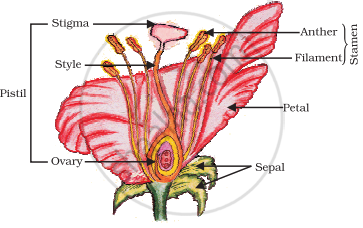Advertisements
Advertisements
Questions
Draw a diagram of the longitudinal section of a flower and label the following parts.
Draw a labelled diagram of the longitudinal section of a flower.
Draw a well-labelled diagram of the longitudinal section of a flower.
Solution 1
Longitudinal section of a flower:

Solution 2

Longitudinal section of flower
RELATED QUESTIONS
A student while observing an embryo of a pea seed in the laboratory listed various parts of the embryo as given below:
Testa, Tegmen, Radicle, Plumule, Micropyle, Cotyledon.
On examining the list the teacher remarked that only three parts are correct. Select three correct parts from the above list:
(a) Testa, Radicle, Cotyleddon
(b) Tegmen, Radicle, Micropyle
(c) Cotyledon, Plumule, Testa
(d) Radicle, Cotyledon, Plumule
Write the names of those parts of a flower which serve the same function as the following do in the animals :
(i) testis,
(ii) sperm,
(iii) ovary,
(iv) egg
A flower may have either male or female reproductive parts. Such a flower is called ______.
Explain what you understand by sexual reproduction.
The process of fusion of the male and female gametes is called ______.
State the name of the functional unit concerned with sexual reproduction.
Name the swollen lower part of the carpel.
What are the reproductive organs in a flower?
What is the name of female organ of a flower (other than carpel)?
Where is the male gamete formed in flowering plants?
Fill in the following blank with suitable word :
Pollen grains contain ............ gametes of a plant.
Fill in the following blank with suitable word :
Flowering plants reproduce by ...........method of reproduction.
What is made in anther of a flower?
Explain the terms 'self pollination'
Give some examples of different modes of fertilisation in nature?
What type of plants reproduce by sexual reproduction method?
Name the part of a seed which contains stored food.
What changes take place in the flower after fertilisation which lead to the formation of seeds and fruit?
Which of the following statements are true for sexual reproduction in flowering plants?
(i) it requires two types of gametes
(ii) fertilisation is a compulsory event
(iii) it always results in the formation of zygote
(iv) offsprings formed are clones
(a) (i) and (iv)
(b) (i), (ii) and (iv)
(c) (i), (ii) and (iii)
(d) (ii), (iii) and (iv)
The correct sequence of reproductive stages occurring in flowering plants is ______
Put a tick mark (✓) against the correct alternative in the following statement
Pollen is produced in the:
Multiple choice question. Tick (✓) the correct choice:
Unisexual flowers are found in
- mulberry
- mustard
- pea
- sunflower
Multiple choice question. Tick (✓) the correct choice:
The male gamete is present inside the which germinates.
- the style
- the stigma
- the anther
- the ovary
Fill in the blanks:
A carpel consists of ________ , ________ and ________.
You have to perform the experiment, "To identify the different parts of an embryo of a gram seed." Describe the procedure that you would follow.
Distinguish between unisexual and bisexual flowers giving one example of each. Draw a diagram showing process of germination of pollen grains on stigma and label the following parts:
(a) Female germ cell
(b) Male germ cell
(c) Ovary
Which of the following is not an unisexual flower?
a) Coconut
b) Papaya
c) Gulmohor
d) Maize
What is pollination? Mention its types.
Answer the following question.
How does suitable pollination lead to fertilization?
What is cleistogamy? Write one advantage and one disadvantage of it, to the plant.
Find an odd one out.
Calyx : Sepals : : Corolla : ________________
Accessory whorls : Calyx and corolla : : essential whorls : ______________
Pollen grains from anther are transferred to the stigma.
Write the functions of sepals
Give scientific reason.
Flower is a structural unit of sexual reproduction in plants.
Give scientific reason.
Fertilization in plants is called double fertilization.
Explain the sexual reproduction process in plants with a diagram.
The male reproductive part of a flower is ______.
The anther wall consists of four wall layers where ______
Flowers showing ornithophily show few characteristic like ______.
The process of release of eggs from the ovary is called ______
In human beings, fertilization occurs in the ______
Which out of the following processes does not lead to the formation of clones.
Which among the following statements are true for unisexual flowers?
- They possess both stamen and pistil
- They possess either stamen or pistil
- They exhibit cross pollination
- Unisexual flowers possessing only stamens cannot produce fruits
In a bisexual flower inspite of the young stamens being removed artificially, the flower produces fruit. Provide a suitable explanation for the above situation.
Give reason for the following:
Fertilization cannot take place in flowers if pollination does not occur.
Where is the zygote located in the flower after fertilization?
Double fertilization is exhibited by ______
Sketch and label the essential and accessory whorls of flower.
The figure below shows the concept of double fertilization. Complete the flow chart showing the progress at each step:

What is puberty?
State the post-fertilisation changes that lead to fruit formation in plants.
